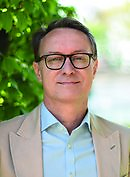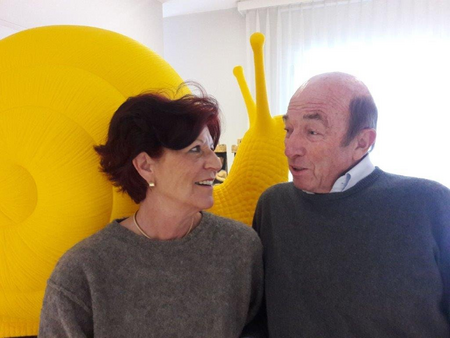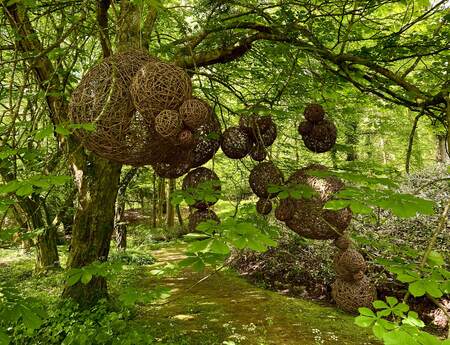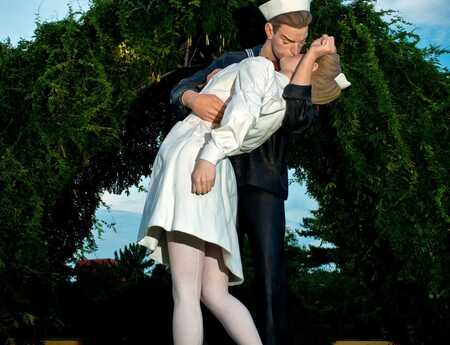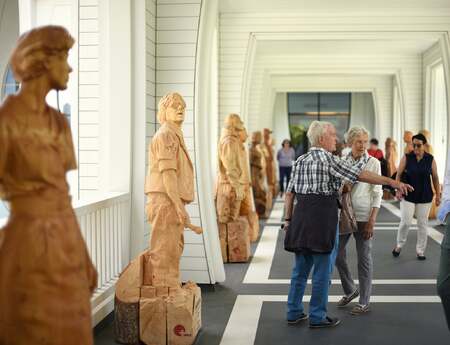"Every Artist is Part of the Family"
Photo: Esther and Rolf Hohmeister
Every three years Bad Ragaz is transformed into the largest Sculpture Park in Europe. Since the year 2000 Rolf Hohmeister, doctor, and his wife Esther, who is also known as a poet, finance the mammoth event as a purely private enterprise. At the time they took on a financial risk. And to this day they still finance a large part of the event themselves. In our interview they reveal what moved them to do so and what part of Bad RagARTz they are proudest of.
What moved you to start the Sculpture-Triennial in Bad Ragaz at the time – even though you had to come up with the means to do so and often times finance it yourselves?
Rolf Hohmeister: Actually it was a protest against the superficial fireworks of the millennial celebrations and against the subjunctive case in general: „Someone ought to, if only someone would“. Everything begins with action. Beyond that we had a dream of giving a present to all the people who don’t have much chance to be in contact with culture and art.
How has the financing changed since then? Does the region or the town of Bad Ragaz contribute to the event?
Esther Hohmeister: Nothing has changed in terms of the private financing. Fund-raising is hard work. Sports events such as Formula 1 have an easier time. Nevertheless, we are pleased that so many private donors are forward-thinking and that they support us and help us realize this dream.
You have expenses – how does the Triennial generate income?
Rolf Hohmeister: Income is generated through sponsors and supporters, by the sales of catalogs and tours, as well as through the sales of sculptures. Plus, the support of so many volunteers saves us some of the expenses.
How long does it take to prepare for the Triennial?
Esther Hohmeister: Every opening weekend is the result of three years of disciplined work. We sat down and calculated that, in addition to our jobs and household, we both invest about 2,300 hours in Bad RagARTz over the three years.
You are known for your extensive support of the artists who have been selected. You take on a lot – for example arranging the transportation of sculptures which often weigh several tons.
Rolf Hohmeister: With its free entry, the Triennial is not just a present to visitors. The artists, who belong to the extended family of the Triennial, should also benefit from the event. For that reason the organization takes care of transportation, construction, insurance, public relations, etc. That really is exceptional and may even be unparalleled in the world.
What criteria do you use when selecting artists? Do you make the decisions alone or is there a committee that supports you?
Rolf Hohmeister: The selection from hundreds of applications is not based on the rules of the art market, but is made with heart, head and a gut feeling. We want to meet the artists in person and to have smelled the dust in their studios. Children and grandchildren, the family and artists and friends all help in making these decisions.
What special emphasis with regard to content were especially important to you for this edition of Bad RagARTz? What are you particularly proud of?
Rolf Hohmeister: The symbols of the current Triennial – a lighthouse and snails – should convey the slogan „Eile mit Weile“ (Go quickly slowly) and represent a sea of more culture. Thousands of people flock to and travel through Bad Ragaz. They follow in the footprints of the artists, they pause to absorb the images and then carry the message back to their families and communities. That makes us proud.
Do you have a personal favorite sculpture?
Esther Hohmeister: Every exhibiting artist is part of our extended family and has sat at our kitchen table. That means they are all equal and every one of them is important.
A large part of the exhibit Bad RagARTz is outside. What role does art in public spaces have these days?
Rolf Hohmeister: Art and nature, towns and people – they all become siblings. This way public spaces don’t need any decorations.
These days your event casts a spell over the entire town. How does the region profit from the fair? Can that be measured in numbers?
Rolf Hohmeister: The spiritual element has become an economic and touristic factor for the towns of Bad Ragaz and Vaduz. Thus, culture can tip the scales.
What are your goals for this year’s event?
Rolf Hohmeister: Art should be an instrument for human culture – for culture as the highest principle of co-existence with respect and responsibility for one another. We hold true to Cicero’s motto, who used the word culture in its modern meaning for the first time in his Tusculan Disputations. He viewed the cultura animi, the care of the spirit, as a necessary extension of the cultura agri, the care of the earth.
Will the fair keep developing and do you already have plans for next time?
Esther Hohmeister: Yes. The Board of Trustees was changed and preparations for 2021 are already underway.
Author: Holger Christmann
Holger Christmann is a
Munich based art reporter
and met Esther und Rolf
Hohmeister in Bad Ragaz
